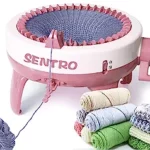How to Hold Knitting Needles: Mastering Comfort and Control for Effortless Knitting
As you embark on your knitting journey, one of the essential skills to master is how to hold your knitting needles. Proper needle holding not only affects your knitting speed and tension but also plays a crucial role in preventing hand fatigue and ensuring an enjoyable knitting experience. While there are various needle holding techniques, each offering its unique advantages, finding the one that suits you best will enhance your knitting prowess and make every project a joy to knit. In this comprehensive guide, we'll explore different knitting needle holding methods, their step-by-step instructions, and tips to improve your knitting efficiency and comfort.
The Importance of Proper Needle Holding in Knitting
Effective needle holding is the foundation of successful knitting. It allows you to control your stitches, maintain tension, and create even fabric. Proper needle holding also reduces strain on your hands, wrists, and arms, making it possible to knit for extended periods without discomfort. Moreover, the right needle holding technique can significantly impact your knitting speed, ensuring efficient progress on your projects.
Basic Needle Holding Techniques
There are two primary knitting needle holding styles: English (Throwing) and Continental (Picking). Each method has its proponents and offers distinct advantages. Let's explore both techniques in detail:
English (Throwing) Style
In the English style, the working yarn is held in the right hand. The knitter "throws" the yarn around the right needle to create stitches.
Step-by-step instructions for knitting in the English style:
- Hold the right needle like a pencil, resting the tip on your right thigh or under your right arm for support.
- Place the left needle under your left arm or against your body for stability.
- Hold the working yarn between your right thumb and index finger, allowing it to drape over your right index finger.
- Insert the right needle into the stitch on the left needle from front to back.
- Wrap the yarn around the right needle from back to front.
- Slide the right needle down and through the stitch on the left needle, creating a new stitch on the right needle.
Pros and cons of using the English style:
The English style is often favored by those who prefer a more controlled and deliberate knitting motion. It allows for consistent tension and is particularly suitable for intricate stitch patterns and colorwork. However, some knitters find this style slower than Continental knitting.
Continental (Picking) Style
In the Continental style, the working yarn is held in the left hand. The knitter "picks" the yarn with the right needle to create stitches.
Step-by-step instructions for knitting in the Continental style:
- Hold the left needle with your left hand, resting the tip on your left thigh or under your left arm for support.
- Place the right needle under your right arm or against your body for stability.
- Hold the working yarn between your left thumb and index finger, allowing it to drape over your left index finger.
- Insert the right needle into the stitch on the left needle from front to back.
- Use your right index finger to "pick" the working yarn and draw it through the stitch on the left needle.
- Slide the right needle down and through the stitch on the left needle, creating a new stitch on the right needle.
Pros and cons of using the Continental style:
Continental knitting is often praised for its efficiency and speed. The minimal movement of the left hand reduces strain, making it a popular choice for those with hand or wrist issues. However, some knitters may find maintaining consistent tension challenging in the beginning.
Other Needle Holding Variations
Apart from the English and Continental styles, there are additional needle holding variations that some knitters may find comfortable and effective. These include the Lever style and the Portuguese style.
Lever Style
In the Lever style, the knitter "levers" the right needle to create stitches. The working yarn is typically held in the right hand.
Step-by-step instructions for knitting in the Lever style:
- Hold the right needle with your right hand, resting the tip on your right thigh or under your right arm for support.
- Place the left needle under your left arm or against your body for stability.
- Hold the working yarn between your right thumb and middle finger, wrapping it around your right index finger.
- Insert the right needle into the stitch on the left needle from front to back.
- Lever the right needle up and towards you, using your right middle finger as a pivot, to "pick" the working yarn and draw it through the stitch on the left needle.
- Slide the right needle down and through the stitch on the left needle, creating a new stitch on the right needle.
Pros and cons of using the Lever style:
The Lever style is known for its speed and efficiency. It requires minimal movement of the right hand, reducing strain on the wrist. However, mastering the Lever style may take some practice, and some knitters may find it challenging to maintain tension.
Portuguese Style
The Portuguese style involves holding the working yarn around your neck or through a knitting pin or hook attached to your clothing. This technique is often used with the Continental style, but some knitters use it with the English style as well.
Step-by-step instructions for knitting in the Portuguese style:
- Secure the working yarn around your neck or through a knitting pin/hook attached to your clothing.
- Hold the left needle with your left hand, resting the tip on your left thigh or under your left arm for support.
- Place the right needle under your right arm or against your body for stability.
- Insert the right needle into the stitch on the left needle from front to back.
- Use your right index finger to "pick" the working yarn and draw it through the stitch on the left needle.
- Slide the right needle down and through the stitch on the left needle, creating a new stitch on the right needle.
Pros and cons of using the Portuguese style:
The Portuguese style allows for a smooth and continuous motion, making it suitable for those who prefer a rhythmic knitting process. It can reduce tension on the hands and wrists, but some knitters may find it challenging to maintain consistent tension with this technique.
Choosing the Right Needle Holding Technique
Selecting the best needle holding technique for you depends on personal comfort, knitting speed, and efficiency. Experiment with different styles to find the one that feels most natural and comfortable. Consider the following factors when making your choice:
Comfort: Choose a technique that feels comfortable and reduces strain on your hands, wrists, and arms. Proper ergonomics are essential for an enjoyable knitting experience.
Knitting Speed: Some knitters find one technique faster than others due to the minimal hand movement or the ease of creating stitches.
Previous Crocheting Experience: If you're transitioning from crocheting to knitting, the Continental style may feel more familiar since it involves holding the yarn in the left hand, similar to crochet.
Project Requirements: Certain projects, such as intricate colorwork or textured stitch patterns, may be more manageable with a particular needle holding style. Choose the technique that suits the demands of your project.
Tips for Holding Needles Ergonomically
Regardless of the needle holding technique you choose, these tips can help you maintain a relaxed grip and prevent hand fatigue:
- Loose Grip: Avoid gripping the needles tightly. Hold them gently but securely to allow for smooth movement.
- Natural Position: Keep your hands in a natural and relaxed position. Avoid bending your wrists excessively or adopting awkward hand positions.
- Regular Breaks: Take short breaks during extended knitting sessions to stretch your hands and reduce tension.
- Even Tension: Pay attention to your tension and ensure it remains consistent to produce even stitches.
- Practice Makes Perfect: It may take time to become comfortable with a new needle holding style. Practice regularly to build muscle memory and knitting proficiency.
Adapting Needle Holding for Specific Projects
Certain projects may require modifications to your needle holding technique to accommodate different yarn weights, stitch patterns, or colorwork. Be adaptable in your approach and adjust your needle holding as needed for the best results.
Conclusion
Mastering how to hold knitting needles is an essential skill for every knitter. The choice between English, Continental, Lever, or Portuguese styles depends on your comfort, knitting speed, and the demands of your projects. Take the time to experiment with different techniques and find the one that feels most natural and enjoyable for you. Remember, knitting is an art, and the way you hold your needles is a personal expression of your craft. Embrace the journey of discovery and find your knitting groove for endless hours of creative joy! Happy knitting!
To find out more about knitting, please visit any of the following areas:
- How to sew together knitting
- What is brioche knitting
- How to join yarn in knitting
- How to join in the round knitting
- How to finish a knitting scarf
- How to make a slip knot for knitting
- How to switch colors knitting
- How to hold yarn when knitting
- What does kfb mean in knitting
- How to fix a dropped stitch in knitting
- How to hold knitting needles
- What is frogging in knitting?
- How to change colors in knitting
- How to count rows in knitting
- How to increase in knitting
- How to slip stitch knitting
- How to yarn over in knitting
- What is a knitting loom?
- How to make bobbles in knitting?
- Where can I buy sentro knitting machine?
- What can you make with a sentro knitting machine?
- Cricut Hat Press: A Comprehensive Guide on Usage - August 13, 2023
- Unlocking Creativity with the Cricut Joy: A Comprehensive Guide - August 12, 2023
- The Ultimate Guide to the Cricut Maker Bundle - August 11, 2023





